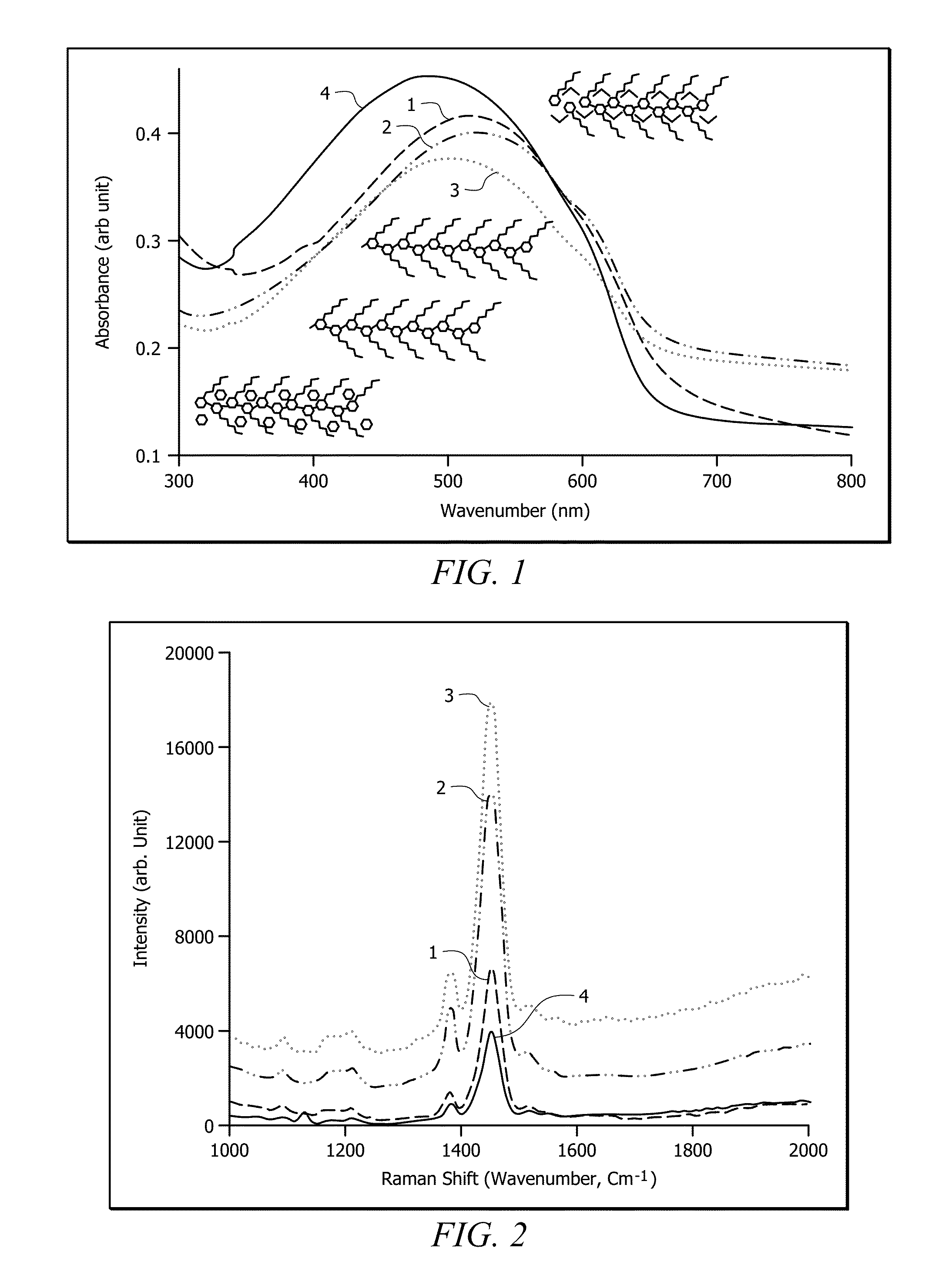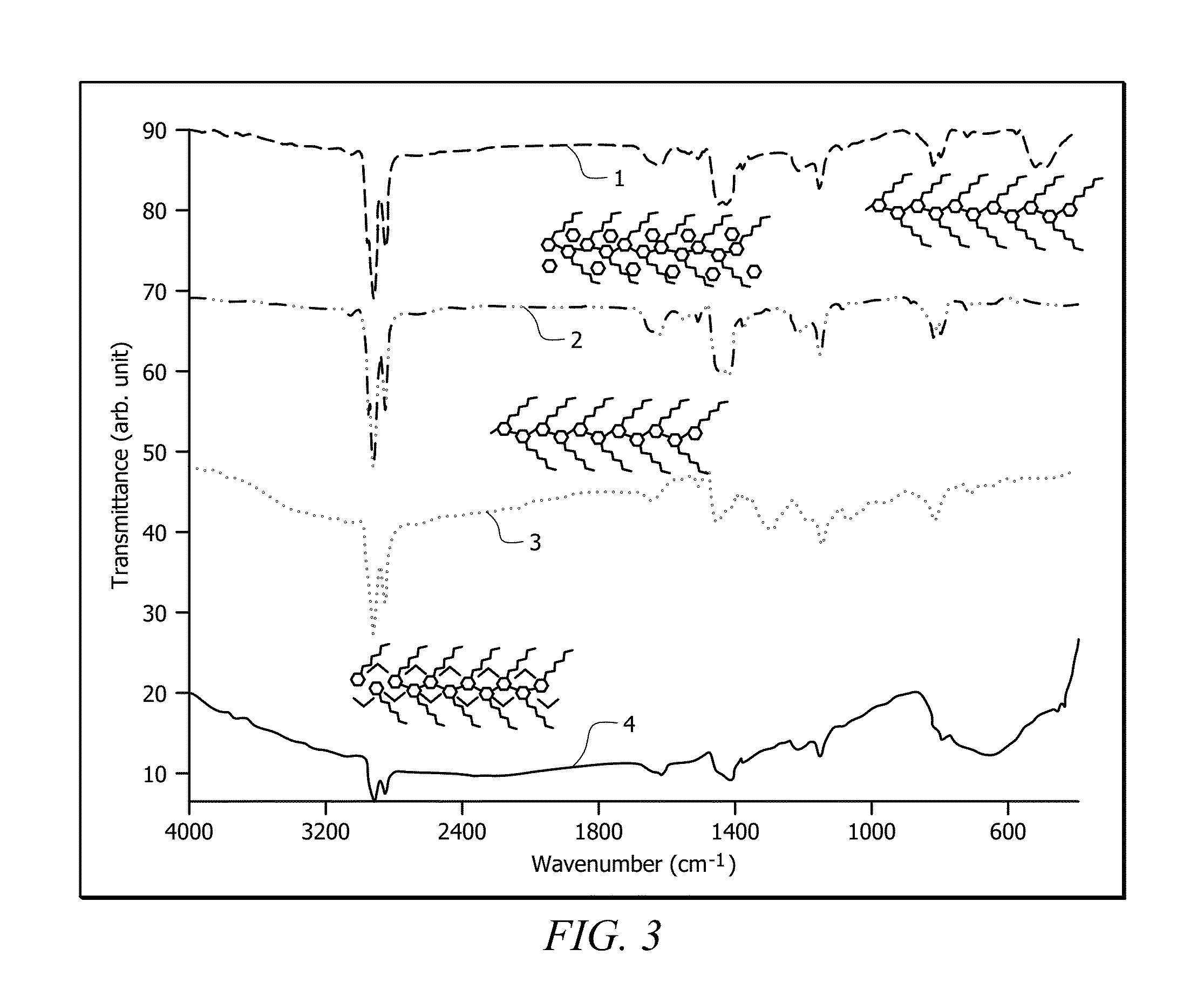Nano-hybrid structured regioregular polyhexylthiophene (RRPHTh) blend films for production of photoelectrochemical energy
a technology of regioregular polyhexylthiophene and nano-hybrid structure, which is applied in the direction of energy input, multiple component coating, and electrolyte coating, etc., can solve the problem of toxic precursor use on a large-scale fabrication alternative, and achieve the effect of improving energy conversion efficiency, enhancing photoconductivity rrphth polymers, and increasing current density
- Summary
- Abstract
- Description
- Claims
- Application Information
AI Technical Summary
Benefits of technology
Problems solved by technology
Method used
Image
Examples
example 1
The Blend Formation of the RRPHTh-Nanoparticles
[0081]RRPHTh, TiO2 (2-10 nm), ZnO (av. 30-40 nm), LiClO4, Camphor sulfonic acid, hydrochloric acid (37%), Acetonitrile, chloroform were all ACS grade, and purchased from Sigma-Aldrich (USA). The diamond nanoparticles (99%, dia 5-10 nm) were purchased from International Technology Center. All these chemicals and materials were employed as purchased without any further purification, unless otherwise specified.
[0082]The RRPHTh and nanoparticles (e.g., TiO2, ZnO and ND) were mixed at 1:1 ratios in chloroform solvent. The RRPHTh was first dissolved and later, equal ratio by weight of TiO2, ZnO and ND separately dispersed in the solution and stirred for 48 hrs. Care must be taken as longer stirred solution shows better blending properties. The resulting solution containing RRPHTh with nanoparticles were deposited on indium tin oxide (ITO) coated glass plates, n-type silicon, and gold coated glass substrates using solution cast and spin coatin...
example 2
Optical Characterization
[0083]Optical spectroscopy is well known technique for characterizing conducting polymer to understand the absorption bands of inter- and / or intra-gap states. FTIR, Raman and UV-vis optical studies on RRPHTh hybrid with TiO2, ZnO, NDs polymers is a preferred tool to derive information regarding the vibrational bands, Raman Shift and absorption bands of the film.
[0084]The vibrational bands of the nano-blend film deposited on (100) n-type silicon single crystal were measured by Fourier transform infrared (FTIR) spectrophotometer (Perkin-Elmer spectrum-1). The sample chamber of the spectrophotometer was continuously purged with nitrogen for 10-15 minutes before the data collection, as well as during the measurements for the elimination of the water vapor absorption. For each sample, eight (8) interferograms were recorded, averaged, and Fourier-transformed to produce a spectrum with a nominal resolution of 4 cm−1. FTIR spectra of nano-blend films were obtained af...
example 3
Surface Characterization
[0090]The hybrid morphology and size of the RRPHTh films blended with nanomaterials were investigated by field emission scanning electron microscopy (FESEM) (JEOL 6340F, operated at 5 kV). Molecular level morphology was investigated using high-resolution transmission electron microscopy (HRTEM) (JEOL 3011 operated at 300 kV).
[0091]The film of hybrid morphology of the RRPHTh alone and RRPHTh with nanomaterials fabricated on SEM was used to measure the SEM studies. FIG. 4(a)-(d) shows the SEM pictures of RRPHTh, ND-RRPHTh, ZnO-RRPHTh, and TiO2-RRPHTh, respectively. It is well known that both the processing methods and the type of solvent used play a critical role both on the degree of organization of conjugated polymer. The SEM analysis does not provide any information on the topography (i.e. height and phase images) of the samples. The RRPHTh picture 4a shows the simple aggregation of the RRPHTh polymer when chloroform was evaporated. The larger-scale roughnes...
PUM
 Login to View More
Login to View More Abstract
Description
Claims
Application Information
 Login to View More
Login to View More - R&D
- Intellectual Property
- Life Sciences
- Materials
- Tech Scout
- Unparalleled Data Quality
- Higher Quality Content
- 60% Fewer Hallucinations
Browse by: Latest US Patents, China's latest patents, Technical Efficacy Thesaurus, Application Domain, Technology Topic, Popular Technical Reports.
© 2025 PatSnap. All rights reserved.Legal|Privacy policy|Modern Slavery Act Transparency Statement|Sitemap|About US| Contact US: help@patsnap.com



